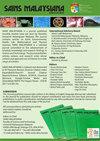Enhancing Herbage Growth, Yield and Quality of Stevia (Stevia rebaudiana Bertoni) using Bio-Organic Nutrients in Varied Soil Media
IF 0.7
4区 综合性期刊
Q3 MULTIDISCIPLINARY SCIENCES
引用次数: 0
Abstract
The present method of stevia propagation is still insufficient to meet its increasing demand. Moreover, the use of organic inputs as substitutes for inorganic fertilizers to improve soil quality and productivity is also desired. In this study, the effects of bio-organic nutrients and different growing media compositions on Stevia’s herbage growth, yield and quality were determined. A completely randomized design was used with 20 rooted stem cuttings per replication at one cutting per potting bag, laid in a 4 × 4 factorial arrangement. Growing Media (garden soil alone [GS]; GS + rice hull [RH]; GS + vermicompost [VC]; and GS+RH+VC) served as factor A while bio-organic nutrients (fermented fruit juice [FFJ]; vermi tea [VT]; seaweed tea [ST] and control) as factor B. There were 16 treatment combinations replicated four times. Results showed that GS+RH+VC consistently improved the survival rate, plant height, leaf and shoot count per plant, weight (fresh and dry), and herbage yield of Stevia. Furthermore, VT boosted the herbage yield and visual quality. In terms of interaction effects, plants grown in garden soil mixed with vermicompost (GS+VC) with VT application developed more leaves than other treatment combinations. Hence, these bio-nutrients and growing media composition significantly enhanced the production of Stevia.在不同土壤介质中使用生物有机营养素提高甜叶菊(Stevia rebaudiana Bertoni)的生长、产量和质量
目前的甜叶菊繁殖方法仍不足以满足日益增长的需求。此外,人们还希望使用有机肥料替代无机肥料,以提高土壤质量和生产力。本研究确定了生物有机养分和不同生长介质成分对甜叶菊草本植物生长、产量和质量的影响。采用完全随机设计,每个重复 20 根茎插条,每个盆栽袋一根插条,按 4 × 4 因式排列。生长介质(园土[GS]、GS + 稻壳[RH]、GS + 蛭石堆肥[VC]和 GS+RH+VC)为 A 因子,生物有机养分(发酵果汁[FFJ]、蚯蚓茶[VT]、海藻茶[ST]和对照)为 B 因子。结果表明,GS+RH+VC 能持续提高甜叶菊的成活率、株高、单株叶片和嫩枝数、重量(鲜重和干重)和草本产量。此外,VT 还提高了药草产量和视觉质量。在交互效应方面,与其他处理组合相比,在施用了 VT 的园土与蛭石堆肥(GS+VC)中生长的植物长出了更多的叶子。因此,这些生物营养素和生长介质成分显著提高了甜叶菊的产量。
本文章由计算机程序翻译,如有差异,请以英文原文为准。
求助全文
约1分钟内获得全文
求助全文
来源期刊

Sains Malaysiana
MULTIDISCIPLINARY SCIENCES-
CiteScore
1.60
自引率
12.50%
发文量
196
审稿时长
3-6 weeks
期刊介绍:
Sains Malaysiana is a refereed journal committed to the advancement of scholarly knowledge and research findings of the several branches of science and technology. It contains articles on Earth Sciences, Health Sciences, Life Sciences, Mathematical Sciences and Physical Sciences. The journal publishes articles, reviews, and research notes whose content and approach are of interest to a wide range of scholars. Sains Malaysiana is published by the UKM Press an its autonomous Editorial Board are drawn from the Faculty of Science and Technology, Universiti Kebangsaan Malaysia. In addition, distinguished scholars from local and foreign universities are appointed to serve as advisory board members and referees.
 求助内容:
求助内容: 应助结果提醒方式:
应助结果提醒方式:


